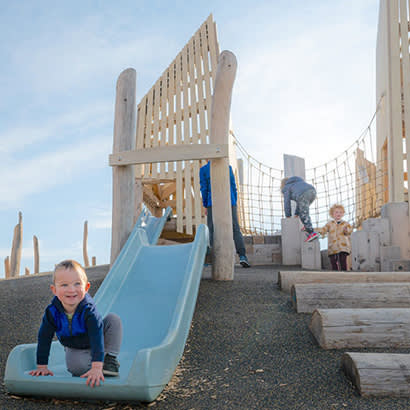
For an enhanced digital experience, read this story in the ezine.
Can a playground tell a complex story? Consider the power of storytelling through playground design. Playgrounds are not just for children — they are community spaces. Collaboration, local voices and stories can be an integral part of their design. Material choices contribute to the stories we tell and can be a response to the growing demand for more sustainable solutions, and access to more natural areas and play opportunities for children.
Storytelling is a powerful design medium — communicating ideas, conveying knowledge, honoring or confronting the past, and challenging us to contribute our own stories. As communities strive toward a renewed understanding of public spaces and their place within them, storytelling is fundamental to the process.
Wanuskewin Heritage Park
At Wanuskewin Heritage Park in Saskatoon, Saskatchewan, the design of the playground was inspired by the site itself and meant to advance the understanding and appreciation of the evolving cultures of the many Indigenous nations that have used the site for living, hunting, gathering and spiritual practice over the course of its 6,000-year history. Several months of community consultation sessions prior to the commencement of project design were undertaken to ensure all aspects of play were culturally appropriate and that the space would provide opportunities for gathering, sharing and learning. Wood was selected as the main construction material because of its haptic and insulating qualities, as well as for our innate connection to and understanding of the natural world. In reinforcing our own connections to the earth, it was imperative that the design utilized sustainably-harvested species of wood. Inspiration for the play elements draw from Indigenous storytelling, bison, rocks and stones, lichen, and the architecture of the nearby interpretive centre. Parents, caregivers and children are invited to play, learn, share and create new stories of their own in connection to nature.
Presidio Tunnel Tops Playground
At the Presidio Tunnel Tops Playground in San Francisco, California, materiality was a driving force behind the story of the playground. With a desire to reconnect the Presidio National Park to the waterfront, the design of each element was inspired by nature and the history of the site. An oriole’s nest can be imagined in the design of the large play nest, while the hydro-tunnel feature tells the story of a subterranean water conveyance system from the 1850s that was discovered during a 2010 archeological survey of the site. The focus on natural materials was woven throughout: found in site features, seating, surfacing, native plantings and play. Nature is clearly the greatest inspiration in the playground’s design as it works in concert with the site to highlight the natural beauty of the Presidio, while inviting both passive and active exploration by both children and adults.
The start of any playground project should strive to make connections to the past, present and future. Material choices can support those connections, and wood as a material choice can speak volumes to the project’s priorities. Storytelling offers a means of reflecting on the past while looking toward the future by creating places where children can write their own stories.
Melissa Quinn is part of the design team at Earthscape Play.

